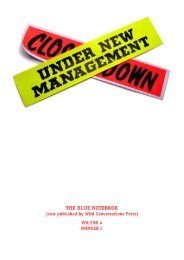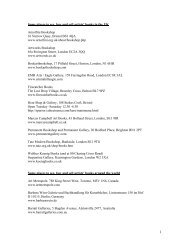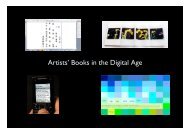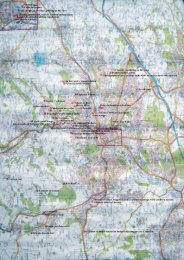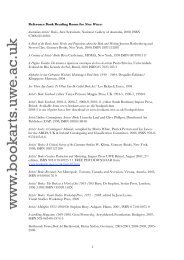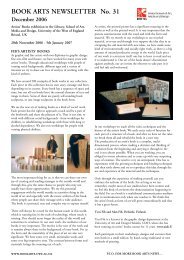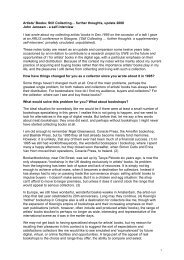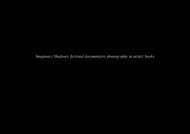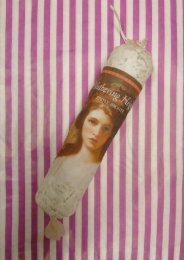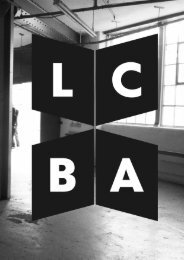Artist's Book Yearbook 2003-2005 - Book Arts - University of the ...
Artist's Book Yearbook 2003-2005 - Book Arts - University of the ...
Artist's Book Yearbook 2003-2005 - Book Arts - University of the ...
Create successful ePaper yourself
Turn your PDF publications into a flip-book with our unique Google optimized e-Paper software.
Sampler, with an essay by art historian Francis<br />
Pound. 16 Copies are used (eight years later) to<br />
accompany an exhibition <strong>of</strong> mainly earlier,<br />
figurative, work by <strong>the</strong> artist. 17 By applying<br />
labels over <strong>the</strong> ‘original’ title, photographic<br />
labels over <strong>the</strong> ‘original’ illustrations, and<br />
running a new text on labels over <strong>the</strong> earlier<br />
text – while leaving some <strong>of</strong> Pound’s text as a<br />
kind <strong>of</strong> frame around <strong>the</strong> new essay –<br />
productive cross-references emerge, and<br />
conventional notions <strong>of</strong> <strong>the</strong> artist’s<br />
‘development’ and <strong>of</strong> time are challenged. The<br />
particular way this artist can use <strong>the</strong> archives <strong>of</strong><br />
his own practice (and its criticism) as fertile<br />
ground for his current practice are particularly<br />
cleverly exposed and fur<strong>the</strong>r constructed in <strong>the</strong><br />
form <strong>of</strong> <strong>the</strong> book itself. A ‘catalogue’ – <strong>of</strong><br />
what, when, and which works, exactly? The<br />
ingredients <strong>of</strong> two exhibitions <strong>of</strong> work<br />
produced at different times are all <strong>the</strong>re, in <strong>the</strong><br />
‘same place’, ‘at <strong>the</strong> same time,’ even if some<br />
is only partly visible: a particularly provocative<br />
conflation – and confusion - <strong>of</strong> catalogue and<br />
‘artist’s book’.<br />
So understated it’s easy to overlook is Julian<br />
Dashper’s small, grey, simply titled Reviews. 18<br />
It contains twenty-seven reviews <strong>of</strong> solo shows <strong>of</strong><br />
this (internationally exhibiting) neo-conceptualist<br />
artist’s work from 1981 – 2001. The reviews<br />
are all by <strong>the</strong> same critic. They are all pretty<br />
negative. Some very. ‘The objects in <strong>the</strong><br />
Dashper exhibition are blindingly dull.’ They<br />
make for hilarious reading. Not an artist’s<br />
book? But, as a collection published by <strong>the</strong><br />
artist, toge<strong>the</strong>r, in book form, <strong>the</strong>y shift <strong>the</strong><br />
writing from its original, occasional, newspaper<br />
context into a domain which has <strong>the</strong> effect <strong>of</strong><br />
productively interrogating <strong>the</strong> role <strong>of</strong> <strong>the</strong> critic,<br />
and exposing <strong>the</strong> role <strong>of</strong> this particular critic in<br />
relation to a strand <strong>of</strong> recent New Zealand art<br />
practice. So framed by <strong>the</strong> artist, this little book<br />
<strong>of</strong> ra<strong>the</strong>r poor critical writing, becomes,<br />
ironically, a ra<strong>the</strong>r good…artist’s book. What<br />
else?<br />
That things are not quite what <strong>the</strong>y seem is<br />
almost an axiom <strong>of</strong> some artists’ books.<br />
At first glance A Little <strong>Book</strong> <strong>of</strong> Relics teases, it<br />
seems just like itself: a child’s school exercise<br />
book, opened out flat (see opposite page).<br />
Anne Noble, better known for her photographs<br />
<strong>of</strong> places and people, uses here a photograph<br />
22<br />
<strong>of</strong> <strong>the</strong> book’s cover as <strong>the</strong> outside <strong>of</strong> <strong>the</strong> package<br />
<strong>of</strong> ‘pages’ – photographed double-pages –<br />
from <strong>the</strong> book she retained from Form III.<br />
The delicacy <strong>of</strong> <strong>the</strong> work is partly achieved by<br />
<strong>the</strong> reduction in scale from <strong>the</strong> original and it<br />
nicely matches <strong>the</strong>ir intimate secretions: pages<br />
with little tufts <strong>of</strong> hair, collaged pictures <strong>of</strong><br />
saints. It is an autobiographical work delving<br />
into childhood memories, which while directly<br />
based on a book, is not one. But it is <strong>of</strong> course<br />
an ‘artist’s book’. Tom Kreisler’s Private and<br />
Confidential also is and is not what it appears,<br />
with its ‘ready-made’ plastic ‘Note Pad’ cover<br />
(see opposite page). It also explores <strong>the</strong><br />
viewer’s curiosity regarding <strong>the</strong> ‘secrets’<br />
concealed within <strong>the</strong> ‘book’, here <strong>the</strong> ‘secrets’<br />
<strong>of</strong> an artist’s mind at work in his notebook, <strong>the</strong><br />
general concept reminiscent <strong>of</strong> Oldenburg’s<br />
Notes in Hand. But Kreisler’s photographed<br />
pages <strong>of</strong> pages are concerned with <strong>the</strong> playful<br />
layerings <strong>of</strong> meanings possible through<br />
combining <strong>the</strong>se with surprising additions, all<br />
within <strong>the</strong> tacky plastic cover. Not quite a<br />
reproduction <strong>of</strong> a notebook, so it must be that<br />
something else, <strong>the</strong>n. Something private,<br />
confidential…and available to <strong>the</strong> public in<br />
multiple copies.<br />
Also apparently not an artist’s book is Megan<br />
Jenkinson’s hardback Under The Aegis, The<br />
Virtues. In conventional academic format, here<br />
is a book <strong>of</strong> scholarly essays by various writers,<br />
Marina Warner among <strong>the</strong>m, on <strong>the</strong> <strong>the</strong>me <strong>of</strong><br />
<strong>the</strong> Virtues in western art, with illustrations. 19<br />
Under The Aegis<br />
Megan Jenkinson, Fortuna Press, Auckland, 1997<br />
Yes, superbly produced, but what makes it<br />
appropriate to this essay? A number <strong>of</strong> factors,<br />
as <strong>the</strong> reader may guess. Firstly <strong>the</strong><br />
‘illustrations’ in <strong>the</strong> centre <strong>of</strong> <strong>the</strong> book. These<br />
constitute forty pairs <strong>of</strong> images, forty double -<br />
page spreads. They are taken from an<br />
exhibition <strong>of</strong> <strong>the</strong> same name.




